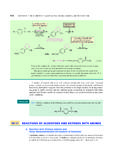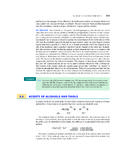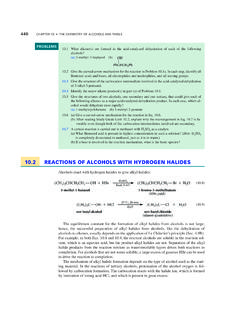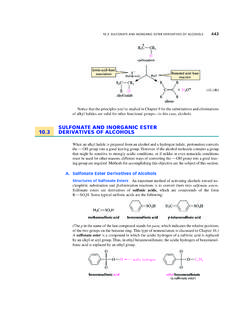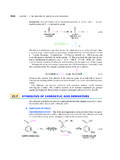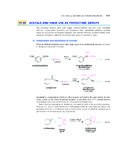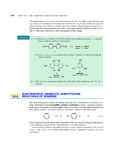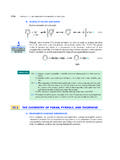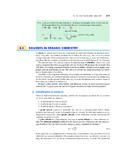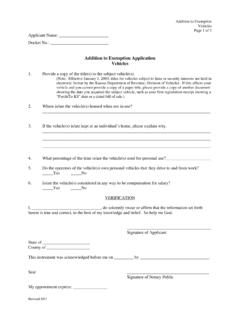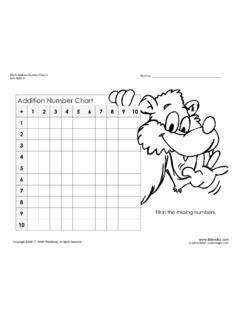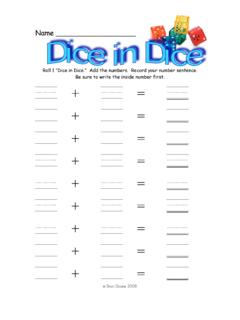Transcription of REVERSIBLE ADDITION REACTIONS OF …
1 REVERSIBLE ADDITION REACTIONS OF aldehydes AND ADDITION REACTIONS OF aldehydes AND KETONESOne of the most typical REACTIONS of aldehydes and ketones is additionto the carbon oxygen double bond. To begin with, let s focus on two simple ADDITION REACTIONS : ADDITION ofhydrogen cyanide (HCN) and hydration ( ADDITION of water). ADDITION of HCN:The product of HCN ADDITION to an aldehyde or ketone is called a a special class of nitriles(organic cyanides). (The chemistry of nitriles is discussedin Chapter 21.) The preparation of cyanohydrins is another method of forming carbon of water (hydration):The product of water ADDITION to an aldehyde or ketone is called a hydrate,or gem-diol.
2 (Theprefix gemstands for geminal,from the Latin word for twin, and is used in chemistry whentwo identical groups are present on the same carbon.)In all carbonyl- ADDITION REACTIONS , the more electropositive species (for example, the hydro-gen of HLCN or HLOH) adds to the carbonyl oxygen, and the more electronegative species(for example, theLCN or theLOH) adds to the carbonyl Mechanisms of Carbonyl- ADDITION ReactionsCarbonyl- ADDITION REACTIONS occur by two general types of mechanisms. The first mechanism,called nucleophilic carbonyl ADDITION ,involves the reaction of a nucleophile at the carbonylcarbon.
3 In cyanohydrin formation (Eq. ), the nucleophile is cyanide ion, which is formedby the ionization of HCN:Cyanide ion donates electrons to the carbonyl carbon of the aldehyde or ketone, and the car-bonyl oxygen accepts the displaced electron pair and assumes a negative charge. We can thinkof this process in the same way that we think of nucleophilic REACTIONS at saturated carbonatoms (Sec. ). The electrophile is the carbonyl carbon, and the leaving group is one ofthe two carbon oxygen bonds of the carbonyl group. Because the other carbon oxygen bondremains intact, the leaving group doesn t actually leave.
4 ( )+pKa = +H2 Ocyanide ionCN_3( )LHOH+LLH3 CHCOHOH""acetaldehyde hydrateLLH3 CCOSH acetaldehyde( )+LLH3 CCOSCH3acetoneLHCN'acetone cyanohydrin(77 78% yield)LLH3 CCOHC""CH3N'pH 9 12/9/08 11:41 AM Page 907908 CHAPTER 19 THE CHEMISTRY OF aldehydes AND KETONES. CARBONYL- ADDITION REACTIONSTo complete the nucleophilic ADDITION , the negatively charged oxygen an alkoxide ion, anda relatively strong base is protonated by either water or nucleophilic carbonyl- ADDITION mechanism finds no analogy in additions to ordinarycarbon carbon double bonds.
5 Yet, nucleophilic carbonyl ADDITION occurs even though the car-bon oxygen pbond is 62 kJ mol_1(15 kcal mol_1) strongerthan the carbon carbon pbondof an alkene. The stronger bond is more reactive because the unshared electron pair (and neg-ative charge) formed in the carbonyl- ADDITION mechanism is transferred to a very electronega-tive atom, oxygen. The same reaction of an alkene would place an unshared pair and negativecharge on a carbon, a much less electronegative reaction of a nucleophile with the carbonyl group, then, is driven by the ability of oxygento accept the unshared electron pair.
6 For this reason, a nucleophile cannot add to the carbonyloxygen. Nucleophiles always react with carbonyl groups at the carbonyl geometry of nucleophilic ADDITION and the reason for it are shown in Fig. The car-bonyl group and the two atoms bound to the carbonyl carbon define a reference plane. The nu-cleophile approaches the carbonyl carbon from above or below this plane, as shown in As a result of this reaction, the carbonyl carbon changes hybridization from sp2to sp3,the oxygen accepts an electron pair, and the geometry at the carbonyl carbon changes from trig-onal planar to tetrahedral.
7 In other words, the angle between the bonds to the carbonyl carbon,initially about 120 , compresses to about 109 , the tetrahedral angle. As a result of the reaction,then, the groups bound to the carbonyl carbon become closer reason for the ADDITION geometry is similar to the reason for backside substitution in theSN2 REACTIONS of alkyl halides (Sec. , Fig. ). The curved-arrow notation might conveythe impression that the nucleophile reacts at the pbond. However, the bonding pmolecularorbital of the carbonyl group (Fig. ) is fully occupied with two electrons and cannot ac-commodate any more electrons.
8 The electron pair of the nucleophile interacts instead with theunoccupiedMO of lowest energy (LUMO), which, in the case of the carbonyl group, is the an-tibonding p* molecular orbital. This MO is shown in Fig. This MO has lobes above andCNCO_""332 LLCN_3 COS%%33observed"CNCC_""3 LLLCCS%%%%CN_3not observed withordinary alkenesadditional unshared pair andnegative charge on oxygenunshared pair andnegative charge on carbon( )CNCO_""332 LLCNHLCNCOH""32LL+CN_3CH3H3 CCH3H3C( )CN_3CO%%33CH3H3 Cone carbon oxygen bond serves as the leaving group nucleophileelectrophileCNCO_""332 LLCH3H3 CSTUDY GUIDE LINK NucleophilesReact at the 12/9/08 11:41 AM Page REVERSIBLE ADDITION REACTIONS OF aldehydes AND KETONES909below the reference plane.
9 The nucleophile, then, must begin its bonding interaction with thecarbonyl carbon from the direction along which the LUMO is concentrated, as shown inFig. the antibonding p* MO is filled, even with electrons from another molecule, theCAO pbond is weakened. (Remember that when an antibonding molecular orbital is popu-lated, the energetic advantage of bonding disappears.) This is the reason that the pbondbreaks. The energetic trade-off for loss of this bonding is formation of the new bond to second mechanism for carbonyl ADDITION occurs under acidic conditionsand is closelyanalogous to the mechanism for the ADDITION of acids to alkenes (Secs.)
10 And ). Acid-catalyzed hydration of aldehydes and ketones (Eq. ) is an example of this first step in hydration is protonation of the carbonyl oxygen (Sec. ).( )COS%%33HL|OH21 COS%%3HL|OH211+ overlapNucantibonding (p*) MO113 NucNuc_ 120! 109!R (a)(b)sp3-hybridizedcarbonsp2-hybridized carbonFigure (a) The geometry of nucleophilic reaction with the carbonyl carbon of formaldehyde, with the nu-cleophile represented by Nuc3_. The reference plane (gray) is the plane defined by the carbonyl group and theatoms attached to the carbonyl carbon.
